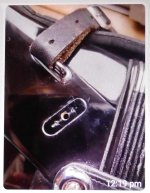I have never—even on the relatively inexpensive Chinese Hohner Bravo and Amica boxes I have tried—felt movement or any signs of weakness in the strap fasteners of any new accordion.
I have difficulty believing such an accordion could have left the Beltuna factory in this condition. While nothing is impossible, it seems more likely to me that damage or incompetent modification occurred at some later time.
I have difficulty believing such an accordion could have left the Beltuna factory in this condition. While nothing is impossible, it seems more likely to me that damage or incompetent modification occurred at some later time.

